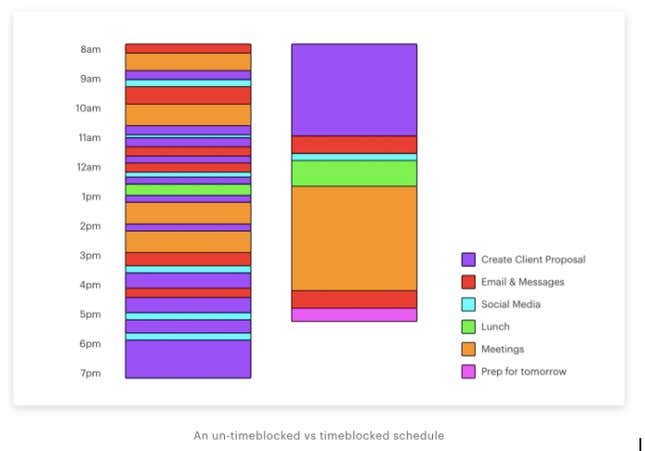Many companies forced to suddenly go remote are compensating with more communication, whether in back-to-back-to-back video calls or all-day team chats, with expectations—stated or implied—that people respond to messages as quickly as possible.
It’s an understandable impulse. Anxious managers want to make sure the pace of work doesn’t slow, while anxious employees want to prove they’re “at work” and not taking advantage of the situation to slack off.
Unfortunately, tethering remote team members to your team communication tools undermines their ability to get things done. Instead of trying to recreate the real-time interactions of the office, team leaders should be doing what remote companies have been doing for years: embracing asynchronous communication.
Asynchronous vs. synchronous communication
Simply put, asynchronous (async) communication is when you send a message without expecting an immediate response. For example, you send an email; I open and respond to the email several hours later.
In contrast, synchronous (real-time) communication is when you send a message and the recipient processes the information and responds immediately. In-person communication, like meetings, are examples of purely synchronous communication. You say something; I receive the information as you say it, and respond to the information right away.
Digital forms of communication like instant messaging are often synchronous, too. You send a message in a chat app like Slack or Teams; I get a notification, and then open the app to read and respond to what you said in near-real time. Even email is treated largely as a synchronous form of communication. A 2015 study conducted by Yahoo Labs found that the most common email response time was just two minutes.
The frantic pace of “real-time-all-the-time” communication
The time employees spend on collaboration has increased by 50% over the past two decades. Studies have found it is not uncommon for workers to spend a full 80% of their workdays communicating with colleagues. According to research from Adobe in 2019, workers spend an average of more than three hours a day on work email, while meetings take up an average six hours per week, though considerably more if you’re a manager.
More recently, instant messaging apps have taken the workplace by storm—the average Slack user sends a reported 200 messages a day, though 1,000-message power users are, as one analytics company has put it, “not the exception.”
This trend toward near-constant communication means that the average knowledge worker must organize their workday around multiple meetings with the time in between spent doing their own work half-distractedly with one eye on email and team chat.

All this real-time communication overhead makes it hard for employees to focus. It drains their mental resources and generally makes it more difficult to make meaningful progress on work. For example:
It leads to constant interruptions. Real-time communication requires constant context-switching, splitting people’s attention and making it more difficult to complete cognitively-demanding tasks – like coding, writing, designing, strategizing, and problem-solving.
It prioritizes being connected over being productive. In real-time environments, team members are incentivized to stay connected and available at all times. If you disconnect, discussions will move on before you’ve had a chance to respond to (or even see) them. To avoid missing out on crucial decisions and discussions, people start checking messages several times an hour, hurting both their wellbeing and productivity.
It creates unnecessary stress. The expectation to be constantly available means that workers lack control over their own schedules. They spend their workdays reactively responding to requests rather than proactively setting their own agenda. One study found that people compensate for the time lost to workplace interruptions by attempting to work faster, leading to “more stress, higher frustration, time pressure, and effort.” This type of synchronous culture quickly leads to burnout.
It leads to lower quality discussions. When you have to respond immediately, people don’t have time to think through key issues thoroughly and provide thoughtful responses. Your first response to any given situation is often not your best response.
It makes it even harder to fully disconnect from work. The rise of mobile technology means that real-time communication is no longer limited to the physical workplace or work hours. We can, and do, check email and respond to messages at any time, day or night, vacation or weekends. As a result, we’re never fully off the clock.
A calmer, more productive way of working
Most people accept distractions and interruptions as just a part of doing business, but remote companies—like Gitlab, Zapier, Automattic, Basecamp, Buffer, and my company, Doist—have been embracing a more async approach to collaboration for years. Here are some of the core benefits of giving employees more control over when they connect to communicate with their team:
Control over the workday = happier, more productive employees. In an async environment, there are no set work hours. Employees have almost total control over how they structure their workdays to fit their lifestyles, biorhythms, and responsibilities (like childcare). Personally, I spend an hour with my son every morning, and no one inside my async organization notices.
High-quality communication versus knee-jerk responses. Async communication is admittedly slower, but it also tends to be higher quality. People learn to communicate more clearly and thoroughly to avoid unnecessary back-and-forths. They have the time to think through a particular problem or idea and provide more thoughtful responses. Instead of knee-jerk responses, people can reply when they’re ready.
Better planning leads to less stress. When last-minute, ASAP requests aren’t an option, advanced planning is a must. People learn to plan their workloads and collaborations more carefully in order to give enough time for coworkers to see and respond to their requests. This leads to less stressful and ultimately higher quality teamwork.
Deep work becomes the default. When employees don’t have to stay on top of each message as it comes in, they can block off large chunks of uninterrupted time to do the work that creates the most value for your organization. They can come back to process their messages in batches one to three times a day instead of bouncing back and forth between work and messages or meetings.
Automatic documentation and greater transparency. Because most communication in an async workplace happens in writing, key discussions and important information are documented automatically, particularly if you use a more team-oriented tool than email. It’s easier to find, reference, and share those conversations later.
Disconnecting at the end of the day isn’t penalized. When conversations happen asynchronously, people can disconnect fully at the end of the workday without fear of missing something important. They’re able to recharge, be present in their lives outside of work, and come back fresh the next day.
Shifting your team to a more async mindset
Async communication is less about the tools you use and more about the habits and expectations that come from the top. It requires that managers focus less on hours worked and more on the actual work being accomplished. It requires that they trust their employees to manage their time wisely and accept the fact that 24/7 connectivity isn’t good for employees’ wellbeing or the company’s long-term bottom line.
To start, evaluate which of your team meetings could happen in writing instead. Empower your teammates to say no to meetings they feel aren’t necessary or bow out of meetings where they don’t feel they’re adding value. Let your teammates know it’s ok to disconnect from your team communication tools—be it email or a chat app like Slack or Teams—during the workday in order to focus fully on their tasks. Set expectations for how quickly teammates should respond to messages on the order of hours, not minutes. And whatever you do, model the behavior you want to see and don’t send emails or messages to your teammates outside of your own work hours.
Async can’t, and shouldn’t, become your team’s only form of communication. Face-to-face connection is still important, now more than ever. There’s a reason remote companies including my own spend thousands of dollars every year on team retreats. Video meetings and just-for-fun group chats are indispensable tools for bringing teams together. But real-time communication should be the exception, not the rule, and never the default expectation.
The companies that don’t require their employees to be always-on—who balance collaborative demands with space for deep work, who provide flexibility in both work hours and location, and who allow employees to disconnect fully when their workday is done—will be the ones who come out of this crisis stronger than before.
Amir Salihefendić is the founder and CEO of Doist, the remote-first company behind the productivity app Todoist and Twist, a team communication app.
